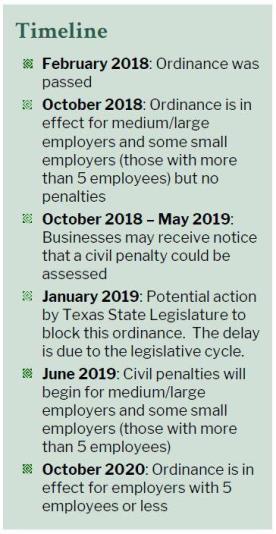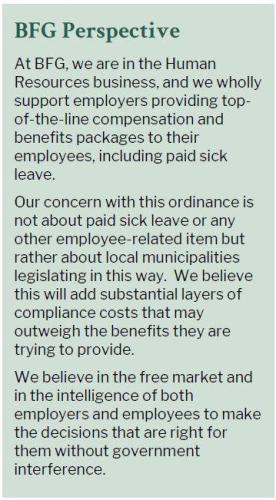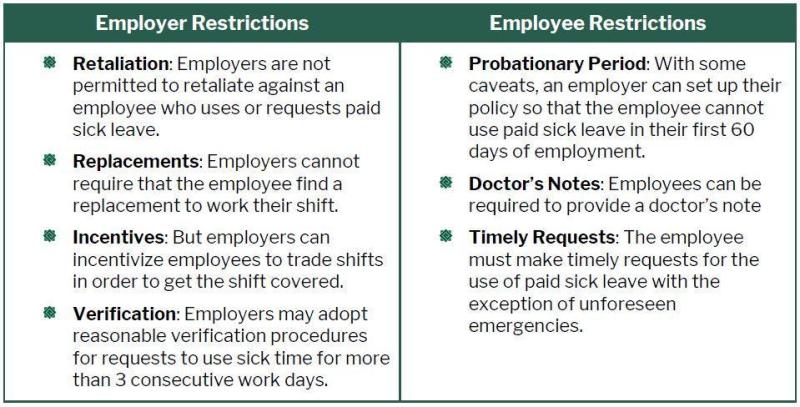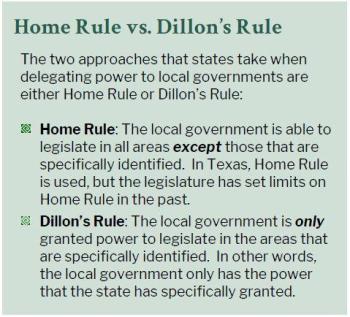6/29/2018
Update on Austin's New Paid Leave Ordinance: Will it Affect You?
Please click here for a PDF copy of this article: Update on Austin's New Paid Leave Ordinance: Will it Affect You?
In February, the Austin City Council passed an ordinance requiring employers to provide paid sick leave to their employees. Any employers whose employees work in Austin are affected, and advocacy groups anticipate similar action taking place in large cities across Texas. Will you be affected?
RECENT UPDATES

On June 18, 2018, State Senator Donna Campbell filed an amicus brief in support of business owners and associations, stating, “In Texas we embrace policies that promote economic prosperity and discourage cities from punishing small business with a patchwork of burdensome regulations that make it harder to keep their doors open. Because most Texas businesses already offer paid sick leave, implementing heavy-handed mandates at the local level on those least likely to afford it will create a less competitive marketplace, harm employers, and put a drag on the Texas economy.”
On June 25, 2018, there was a temporary injunction hearing on this issue, which was denied by Judge Tim Sulak of the Austin District Court after two days of testimony. The case is next going to the appellate court, which may have a different result.
In addition, business owners and associations are working on legislative action at the state level to fight more than just this ordinance, but any labor or employment ordinance a city tries to pass that is outside of their jurisdiction, which covers a broad base of labor laws.
The Texas State Legislature has promised to squash this ordinance but cannot do so until 2019 when they are in session. Many are concerned that at that time, if several of these ordinances are in place, it may be bad optics to squash them.
WHO IS AFFECTED?

The ordinance requires employers in Austin to provide paid sick leave to their employees. It defines “employee” as “an individual who performs at least 80 hours of work for pay within the City of Austin in a calendar year for an employer, including those who performed through the services of a temporary or employment agency.” Part-timers and temporary employees are eligible.
If an employee is rehired within 6 months of their termination, they should retain the paid sick leave balance they had prior to termination.
In addition, the ordinance also applies to transfers (including out-of-city transfers): If an Austin employee is transferred to San Antonio, they should still have access to the sick time that they accrued before the transfer. (The City of Austin does not have jurisdiction in any other cities, but the ordinance does specifically make this allowance for out-of-city transfers.)
WHO IS NOT AFFECTED?
The ordinance does not require providing paid sick leave in the following circumstances:
- Terminated employment: The ordinance does not address terminated employment (whether the employee quit or was fired) and so will not require employers to pay terminated employees for their unused paid sick leave.
- Employers who have a PTO policy in place that exceeds the requirements of this ordinance (i.e., the applicable cap)
- Independent contractors
- Unpaid interns
- Government agencies (government workers, state agencies)
WHAT ARE THE REQUIREMENTS?
The ordinance states that employees should accrue 1 hour of paid sick leave per 30 hours worked, with the following caps:

The paid sick leave can be used to care for a family member or someone who is like a family member to the employee. The ordinance allows employees to carry unused time to the next year as long as they do not surpass the cap; however, if the employer provides the paid time off in a lump sum at the beginning of the year, they do not need to include any carryover because the employee will have the full amount of paid leave.
In addition to providing paid sick leave, the ordinance requires employers to
- Provide a monthly statement to each employee with their paid sick leave balance
- Post a notice in all appropriate languages (once the City of Austin has made it available)
- Update their employee handbooks to include the paid sick leave policy and a statement on employee rights
Some restrictions may apply to the employer and the employee:

PENALTIES
This ordinance will be enforced by the City of Austin’s Equal Employment and Fair Housing Office. Complaints can be filed by or on behalf of the affected employees up to two years after a violation. Most penalties will not be in effect until June 1, 2019, with the exception of penalties for retaliation, which will be in effect starting October 1, 2018. In both cases, businesses will have 10 days to “establish voluntary compliance with the Ordinance” before a penalty is assessed.
There is a window of time from October 2018 through the end of May 2019 when businesses may receive a notice that “a civil penalty shall be assessed for a violation that occurs after June 1, 2019, if the Respondent fails to establish voluntary compliance with the Ordinance…within 10 business days.” The rules remain unclear as to whether or not penalties will be assessed for violations occurring during this window from October 2018 through the end of May 2019.
The maximum penalty is $500 per violation; however, at this time, it is not clear what constitutes a “violation.” It could be per policy, per employee, or other. The penalties are phased in as follows:
- Small Employers (with 15 or fewer employees) will face fines starting at $100 for the first violation, $150 for the second violation, and $300 for the third violation.
- Medium/Large Employers (with 16 or more employees) will face fines of $150 for their first violation and $300 for their second violation.
The penalties can vary further based on number of employees and perceptions about whether the employer is making an effort to comply or seems to be disregarding the ordinance. This has been criticized by Austin Independent Business Alliance’s (AIBA) Executive Director, Rebecca Melançon, who stated, “This is an attitude penalty…’Now we can penalize you more if we don’t like your attitude.’ That, to me, is over the line and very subjective.”
INVESTIGATIONS
If an employer receives notice of a penalty, they will be given 10 days to become compliant. If they do not, they may be subject to a penalty. The process for investigating and assessing whether the employer will have a penalty is as follows:
- Within 2 days after a complaint is received, it will be assigned to an investigator.
- Within 10 days of the assignment, the investigator will attempt to schedule an interview with the employee, give the employer a copy of the complaint, and request information from the employer.
- The employer will have 21 days to respond and could be served with a subpoena if they do not respond.*
- Within 90 days of the assignment, the investigator will submit a recommendation to the Equal Employment and Fair Housing Office’s administrator.
- Within 15 days, the administrator will do one of the following
- Dismiss the complaint.
- Instruct the investigator to continue reviewing the complaint.
- Issue a “written notice of violation” to the employer. This decision is final.
*Employers who are forced to comply with a subpoena may be charged with criminal offenses. If subpoenaed, officials can review all employment records, even those that are unrelated to the violation.
CONCERNS AND POTENTIAL IMPACT

Keep in mind, the federal government does not require a company to offer paid sick leave. For companies based in other municipalities, it is important to be following what is taking place in Austin. While this will be the first municipality in Texas to add required sick leave policies, other cities like Dallas and San Antonio are considering similar mandates. Unless the Texas Legislature takes action, we have to assume a similar ordinance would be enacted in every major city in Texas. Since 2011, over 40 state and local governments now require some type of paid leave. This is a growing trend, and there is speculation that other employer mandates are being pursued at the local level, such as minimum wage and fair scheduling.
This ordinance states on page 1: “Denying earned sick time to employees: is unjust, is detrimental to the health, safety, and welfare of the residents of the City; and contributes to employee turnover and unemployment, and harms the local economy.” What remains to be seen is the reality of what this ordinance will actually accomplish, which has many business owners and business associations concerned. Some considerations are as follows:
Cost
One employer of 300 in Austin estimated his costs due to the new ordinance would be $5,000 per week or $20 per week per employee.If this is the trend, many business owners said they may need to raise prices, reduce benefits for employees, cut pay or planned raises, limit scheduling flexibility, and even lay off employees.
Compliance
A major concern is compliance and enforcement.If this ordinance stands, employers will need a separate process for employees in Austin.And if Dallas enacts a similar ordinance, employers may need multiple processes for employees based in Austin, for employees based in Dallas, and employees based elsewhere. Managing compliance with multiple municipal governments may be a significant administrative cost.
Clarity
The purpose of this ordinance is to mandate that employers provide paid sick leave to employees working in Austin; however, important, foundational definitions within the ordinance are very unclear.For example, an employee is defined as an “individual who performs at least 80 hours of work for pay within the City of Austin in a calendar year for an employer.”This definition does not merely apply to someone who has a physical office in Austin and has the following implications:
- A delivery company based in San Antonio that makes deliveries around the state could have regular customers in Austin. Over the course of a year, one driver could easily accrue 80 hours of work within Austin, which seems to make them eligible for paid sick leave under this ordinance. And multiply that times every city with such an ordinance.
- An Austin-based company of 30 could have one employee working remotely out of Cedar Park and all others working in Austin. Per this definition, this ordinance may not apply to the employee in Cedar Park, even though they are employed by a company based in Austin and are a short drive away. It may only apply to them if they work 80 hours in Austin in a calendar year.
- Conversely, a staffing company based in Cedar Park could place employees in jobs at Austin-based companies. These employees log many more than 80 hours working for companies in Austin, but all work remotely and are not physically in Austin. This arrangement could apply to IT, sales, design work, engineering, and so on. Would this ordinance apply to these employees?
- For that matter, companies in all 50 states could have employees who do work for Austin-based customers, whether they spend time in Austin or not. How would the rules apply to these companies?
Perceptions of the City
This ordinance may discourage growth in Austin and even encourage businesses to leave.According to AIBA, when surveyed, “some [business owners] even stated that they would move out of Austin city limits, citing this as the final straw from a city they don’t believe supports them.”Likely this sentiment by business owners will be similar in other cities as well.
Perceptions of Texas
Texas is widely viewed as a business-friendly state by those within and without the state.Many are concerned that this type of legislation at the municipal level of government, if it continues to spread, may change this view from Texas-based businesses, may affect perceptions of those outside of Texas, or make a business reconsider moving here.
True Impact
A majority of businesses in Austin already offer paid leave.A 2013–2015 study shows that only 37% of Austin’s total workforce and 29% of Austin’s full-time workforce lacks paid sick leave.As stated above, the ordinance itself excludes independent contractors, who make up an estimated 30–50% of workers in the construction and maintenance and other industries.This raises the question of whether ordinances like this will truly have the desired impact.
Referring back to the statement on the first page of the ordinance, quoted above: Will this ordinance contribute to health, safety, and welfare?Will it reduce turnover and unemployment?Will it help the local economy?
In 2014, Seattle voted to increase their minimum wage to $15 per hour.While intentions were to improve the lives of low-income employees, a 2017 study conducted by economists at the University of Washington found that employers have since cut their payrolls, put off new hiring, reduced hours, or laid off employees.In fact, the study found that the costs of this ordinance outweighed the benefits 3 to 1.
MOVING FORWARD
The progress of this ordinance will be important to watch, as it has implications for other municipalities and political and social issues, such as minimum wage and fair scheduling ordinances. BFG will continue to monitor the situation and will release updates as we learn more. Please contact our office if you have any questions.